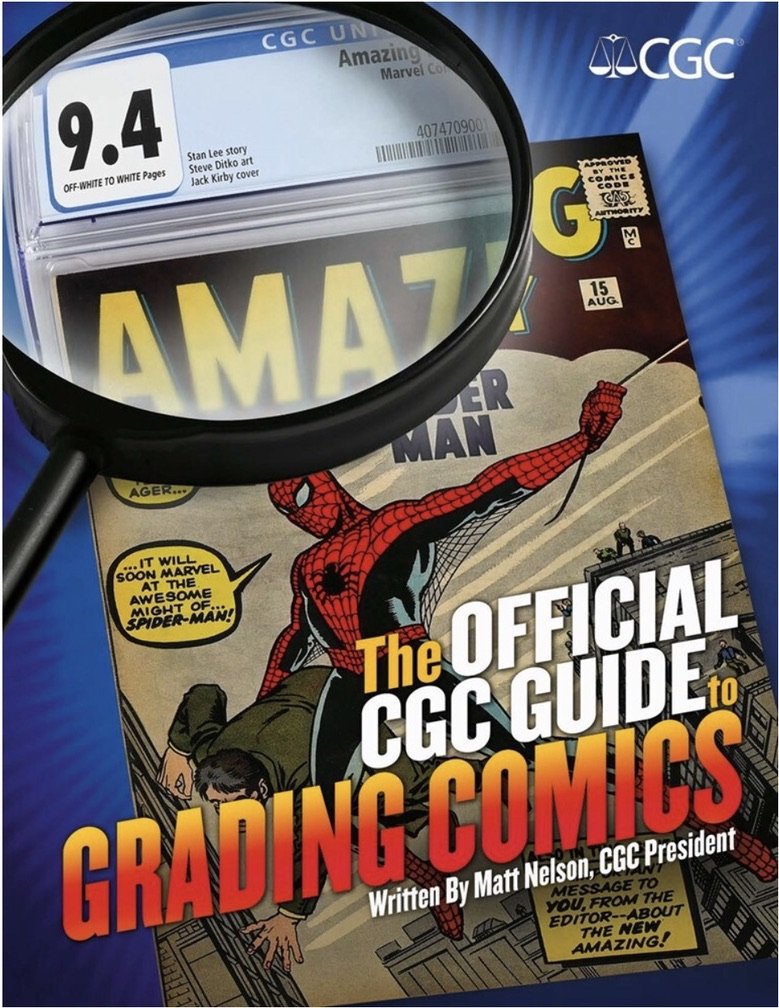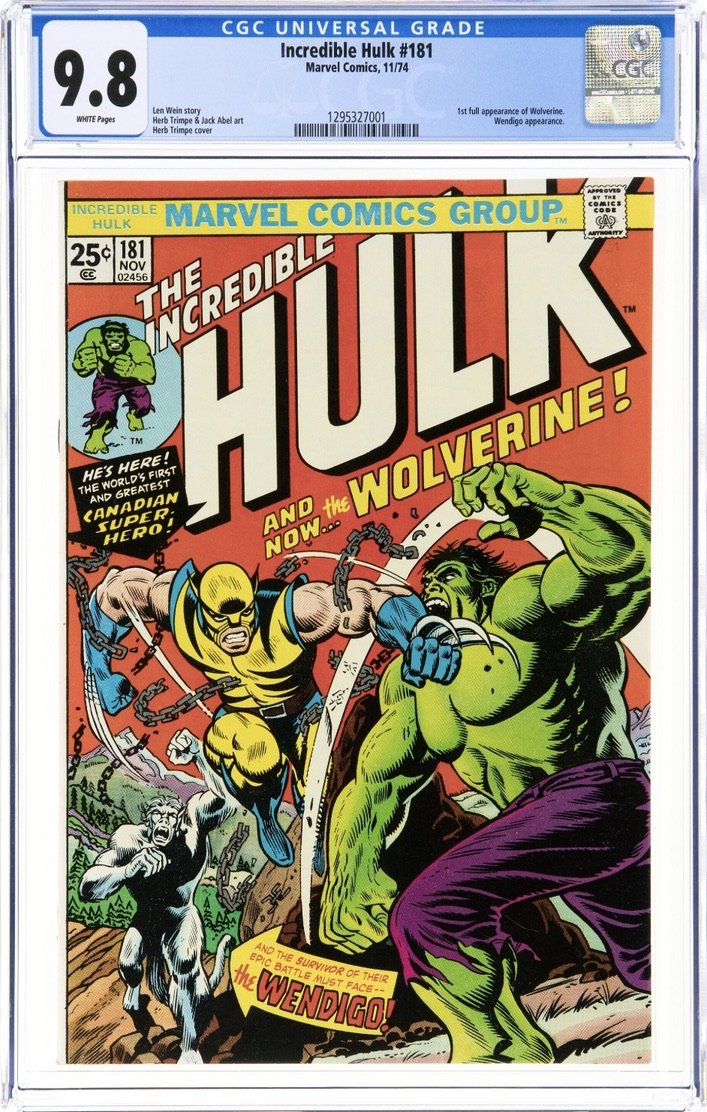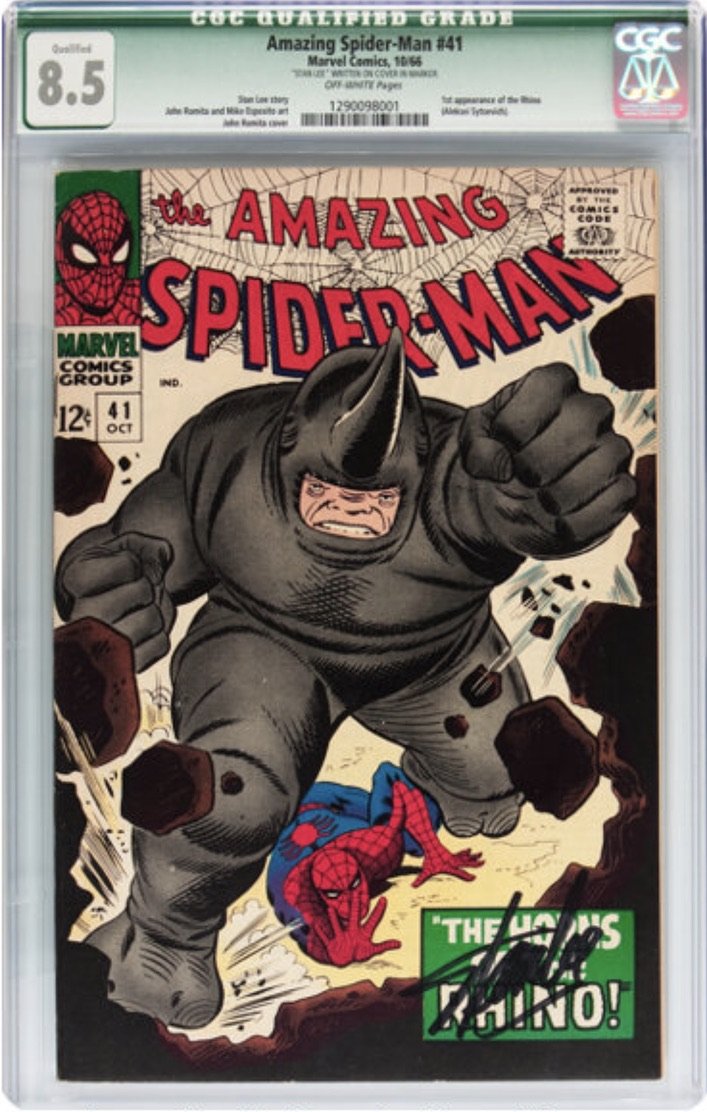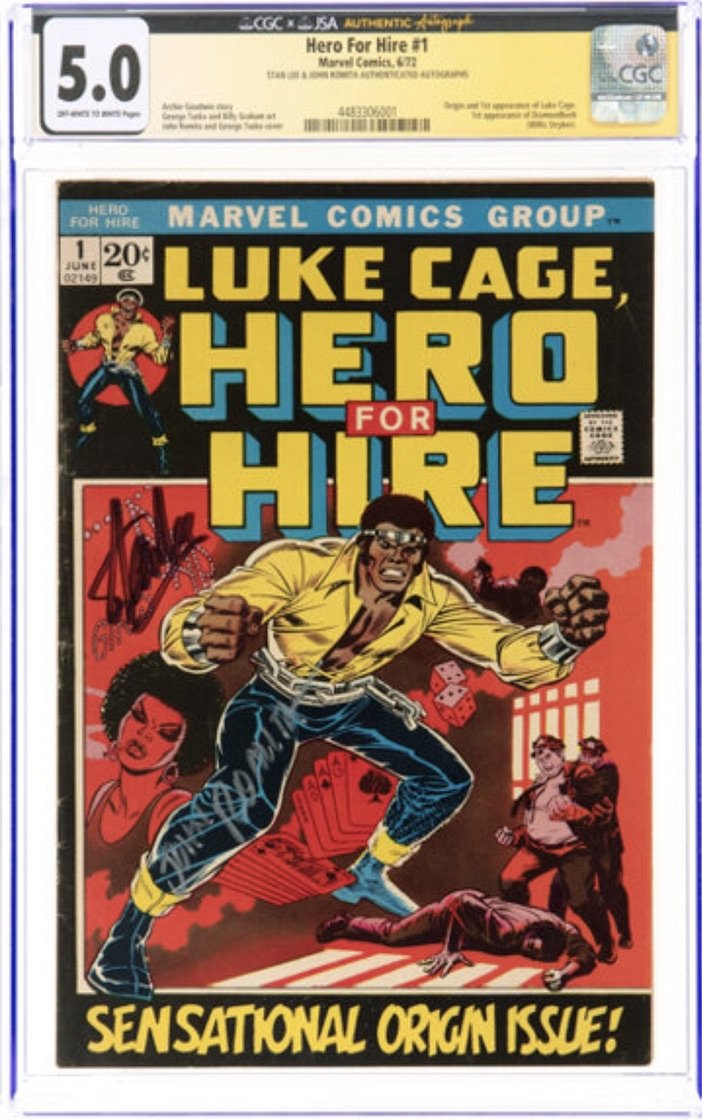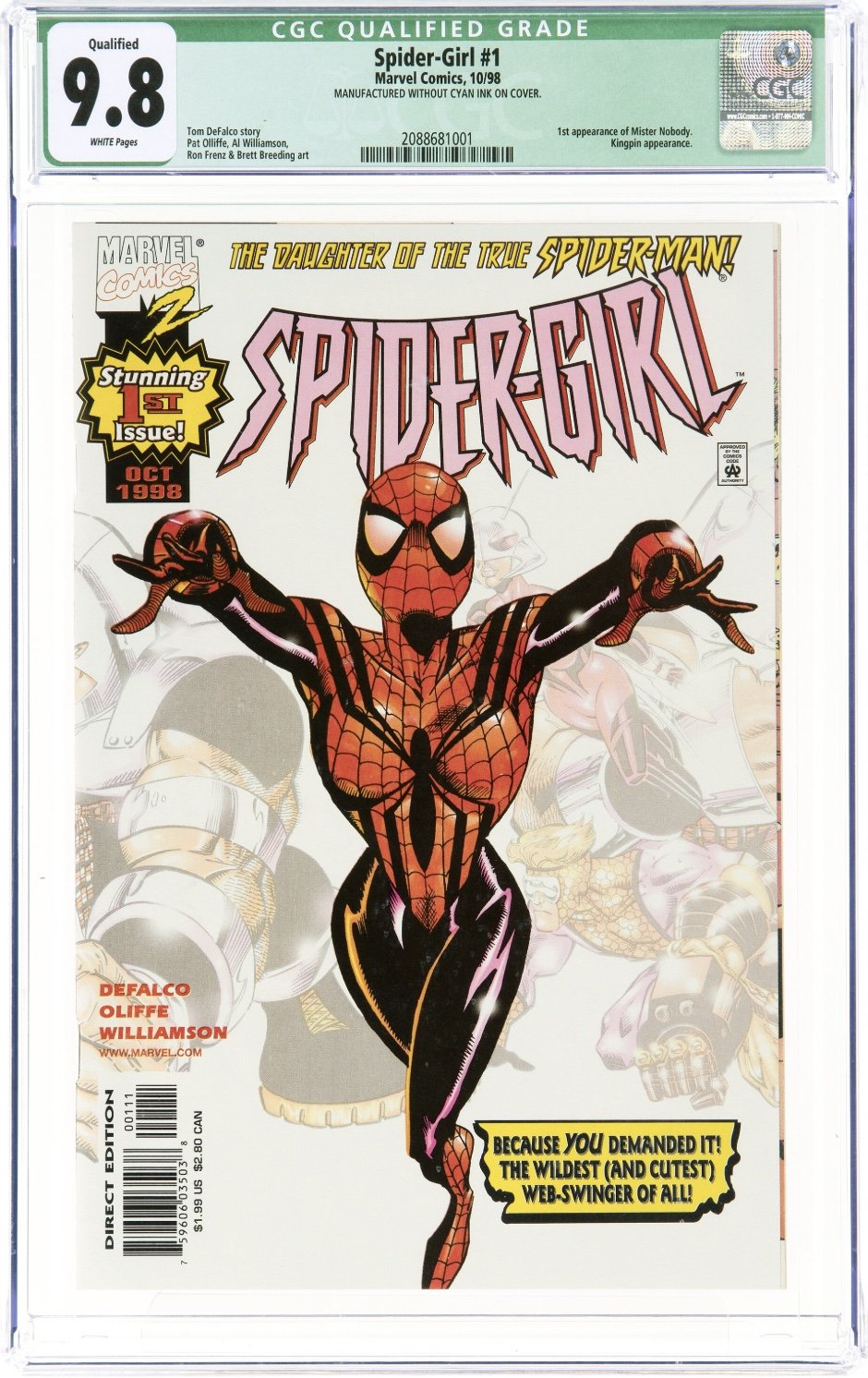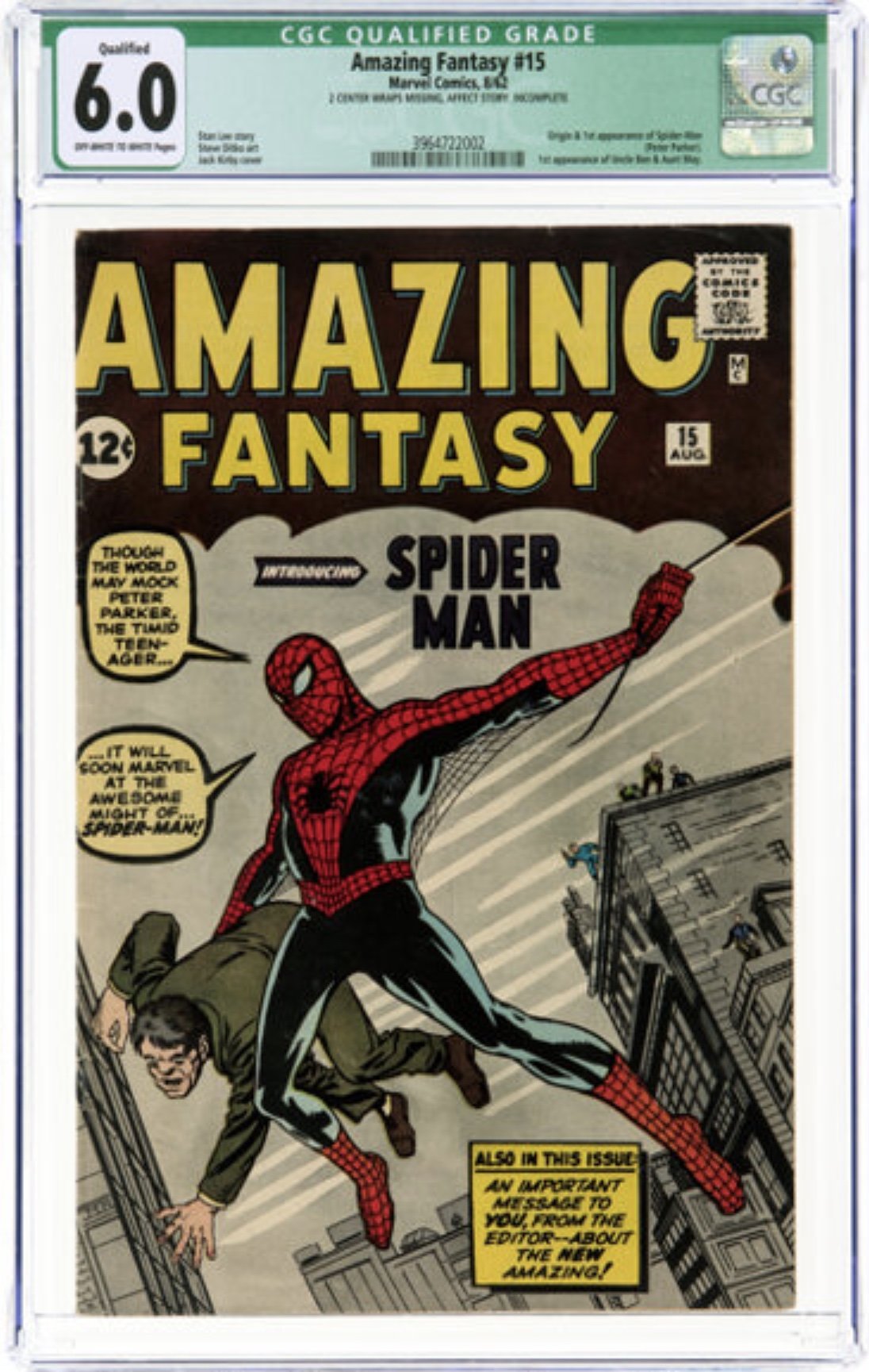CGC's Green Label of Confusion
Green is a color that often carries powerful meaning. On one hand, it symbolizes health and life: think of the green grass after a spring shower or the vegetables we’re encouraged to eat. On the other hand, green can represent less-than-ideal traits, like jealousy ("green with envy"), greed ("green with greed"), or even illness ("so sick they looked green!").
For many comic book collectors, CGC's Green Label brings about confusion. This color is used to denote a “qualified” grade.
Let me get straight to the point. If you're just starting out in comic book collecting, I suggest you avoid Green Label books for now—and maybe check out this article instead. As you gain more knowledge and experience, it might make sense to explore them further.
However, if you're an intermediate or advanced collector, keep reading. This article could help you become a more discerning judge of whether to add a qualified book to your collection—and, if so, at what price. In my opinion, qualified books can still be solid investments and, in some cases, offer great opportunities. For you, green might represent "proceed with caution" rather than confusion.
I’ll cover common questions about qualified books and finish with some rules of thumb for buying them. It’s also worth noting that Nelson's The Official CGC Guide to Grading Comic Books (2022) is an excellent resource for understanding the Green Label and provides a more in-depth explanation than I can offer here. I refer to it frequently in this article.
What Does “Qualified” Mean, Exactly?
Nelson (2022) explains that "qualified" means "limited or restricted," which is essentially what this label indicates—there’s some limitation on an otherwise universally graded comic book (p. 43). To put it simply, think of a Green Label as a Blue Label book with a catch. And beware—this "catch" could be anything from a minor issue to a major one.
What Percentage of Comics Are Green Label Books?
According to an article by Greg Holland, about 1% of CGC graded comics received the Green Label, which is roughly the same percentage as comics with the purple (restored) label. However, it may feel more common due to high-profile books like Hulk #181 (the first full appearance of Wolverine). Not only does Logan battle the muscular green monster, but he also seems to run into the Green Label much more frequently, with about 6.5% of Hulk #181 copies receiving the qualified grade!
What is the Green Label Conundrum?
An insightful article on pojo.com explained the dilemma many comic book collectors face. Imagine you have enough money to buy a Blue Label (universal) comic, but only in a low grade. Alternatively, you could get a much higher-grade, better presenting Green Label copy of the same issue for the same price. Which do you choose? This is where the main conundrum lies: a rough-looking universal copy or a visually appealing Green Label copy?
The more nuanced version of this question is: under what circumstances does it make sense to buy a Green Label book instead of a Blue Label one? We'll dive into that later. For now, let’s take a closer look at the Green Label itself, as not all qualified books are created equal.
What Are the Categories of Qualified Books?
Collectors who view the Green Label as an umbrella category for miscellaneous “oddities” should be forgiven—it often feels like the label represents a catch-all for comics that don’t fit neatly into other categories. In a way, it’s like that kitchen drawer where miscellaneous items are tossed in, simply because they don’t belong anywhere else.
Despite this perception, there’s some order behind the chaos. Nelson (2022) outlines three sub-categories for Green Label comics: Defects, Printing Errors, and Married Parts. Quotes in this section are from Nelson’s guide.
Category A: Defects
"Defects that may trigger a qualified grade include missing parts, detached parts, and writing on the cover.” Other than writing on the cover, defects eligible for a Green Label are often tough to detect unless you open the comic up and closely inspect it. Common examples include missing pages, missing coupons, missing inserts, or staple detachments (e.g., a detached centerfold).
However, having one or more of these defects doesn’t automatically guarantee a Green Label. The defect must be significant enough to drastically lower the grade. For example, if a comic would otherwise grade as a 9.4 Blue Label but is missing its centerfold, the comic could still be graded as a 9.4 but receive the Green Label. From a Blue Label perspective, the missing centerfold would likely drop the grade to a .5 (as it’s an incomplete book). Because the defect is internal and results in such a dramatic grade reduction, the book may instead receive a 9.4 Green Label, noting the missing centerfold. The Official Guide provides detailed criteria for when the Green Label may be triggered. For example, a book missing a centerfold generally needs to present as a 3.0 or higher to earn a Green Label. If the comic grades at a 2.5, it would likely receive a Blue Label.5, as it doesn’t meet the 3.0 threshold.
Category B: Printing Errors
"Qualified printing defects include those that considerably affect a book’s appearance.” We’re not talking about minor issues like a slight miscut or a faint color strike. These printing errors need to be extreme. For example, a comic could have such a severe miscut that it looks lopsided, or the registration could be so off that the cover appears 3-D (even before you put on the glasses). A cover could be missing a color entirely, or the printing might be noticeably flawed in other ways.
Category C: Married Parts
“Married parts include married covers, wraps, pages, parts of pages, and inserts.” In this context, “marrying” refers to combining parts from two or more books to make one complete copy.
For example, a collector might only have the cover (front and back) of a comic, but then find a complete interior of the same issue. The collector might then combine the two parts into a single, complete comic. The hope is that a complete book will sell for more than the individual parts would. The sharp-eyed reader might wonder...
Why Do Comics with Married Parts Receive the Green Label Instead of the Purple Label?
According to Nelson (2022), the Purple Label indicates restoration, which “...returns a comic book to its ideal state by replacing missing parts of a comic book using foreign material” (p. 25). Common restoration techniques include color touch, tear seals, piece fills, and glue. Essentially, restoration involves manipulating a book to improve its appearance by adding material from outside the original comic. The key phrase here is using foreign material.
In contrast, when parts are married from the same comic issue, they are not considered foreign material. As a result, married parts do not fall under the category of restoration. Therefore, the Green Label is applied to comics with married parts, rather than the Purple Label reserved for true restoration.
To further clarify the difference between restoration and qualification, let’s use an analogy. Imagine a person sustains a severe leg injury, like a compound fracture, and parts of their femur need to be replaced. During surgery, there are two options: either graft synthetic bone or use real femur material harvested from a cadaver. From a comic book perspective, using synthetic bone is like restoration—a purple-label surgery, because the leg is made whole with foreign material. On the other hand, using a cadaver’s femur is similar to a Green Label surgery: the replacement part is from another, similar person, not something entirely foreign.
Has the Green Label Been Assigned Consistently Over the Years?
This is a tricky question. Qualified books have existed since CGC was founded in 2000. For the most part, the vast majority of books that received the qualified grade in 2000 would still receive the same qualified grade in 2025. However, CGC’s grading practices have evolved over time, which has affected how certain books are categorized. And, admittedly, books that receive the Green Label are difficult to categorize conceptually and practically.
For example, CGC used to only verify signatures if an employee personally witnessed the comic being signed. These books would then receive the Yellow Signature Series label. An unwitnessed signature, however, was considered a defect, meaning that many high-grade comics with unwitnessed signatures were assigned the Green Label.
In May 2024, CGC partnered with James Spence Authentication (JSA) to authenticate signatures that were not witnessed. Comics authenticated through this process now receive the CGC x JSA Authentic Autograph label. As a result, many comics with unwitnessed signatures, previously assigned Green Labels, may now be eligible for this new label.
Another example involves how CGC has handled replaced staples. Between 2000 and 2013, if a comic had replaced staples (and no other work done), it would receive the Green Label. However, in 2014, CGC introduced the Conserved designation, and comics with replaced staples now fall under the Blue-with-Gray label, instead of green. This highlights the complexity of CGC's label system. For more clarification, I recommend reading Nelson's book.
Are There Different Shades of Green in the Qualified Label?
Literally speaking, no. The actual Green Label is the same shade of green across all graded comics. But figuratively, collectors should think of qualified books as having different "shades" of green.
Consider the severity of defects. One comic might be missing just a small coupon, while another could be missing nearly half of its interior pages. Both would receive the Green Label, but the first is a "light green" and the second is a "dark green" due to the difference in severity.
Similarly, printing errors can vary in intensity. A comic could have missing staples, or it could be so poorly printed that the cover image looks like a 3-D effect without the glasses. These issues would also represent different shades of green, depending on how significant the error is.
When it comes to married parts, it could range from a single interior fold being replaced (a relatively small part of the book) to combining parts from multiple copies to form a complete comic. Again, this variation suggests that some Green Label comics are "lighter" than others, depending on the scope of the defect or alteration.
In any case—whether it’s defects, printing errors, or married parts—be sure to consider the shade of green before making an offer on a comic.
Why Are Green Label Comics So Difficult to Price?
Pricing is the primary reason I advised novice collectors to steer clear of Green Label books earlier in this article. Experienced collectors know there’s no simple formula for determining their value. Plus, there’s a lot of popular (but bad) advice about pricing qualified books that can lead a beginner astray. I’ll share some of that misguided advice and offer what I believe is more sound guidance. But first, let’s dive into some real-world price data.
One of the best ways to introduce pricing for qualified books is to look at the comic most infamous for receiving Green Labels: Hulk #181. It’s a straightforward example because:
The vast majority of Green Label issues of this comic are due to a missing value stamp.
There’s enough sales data to understand the price difference between Blue and Green Labels.
General Inferences from This Data
Let’s break down some general observations:
From around the 3.5 to 7 range, Blue Label Hulk #181 books sold for roughly $500 per grade point.
As you move into higher grades, the price per point increases significantly, which is common for bronze, silver, and golden age comics.
Green Label books tend to hover around $250–$300 per point up to about a 7.5 grade.
In higher grades, the price per point for Green Label books increases, but the acceleration is much less steep compared to Blue Label prices.
As far as market guidance for Green Label books, you can’t get much richer than this data. For qualified Hulk #181 books where the value coupon is missing, pricing around 50–60% of the Blue Label price is consistent with the market. In high-grade books, though, the discount should be much more significant— as low as 10–15% of the Blue Label price for a 9.8.
Common (and Bad) Pricing Advice
There’s a lot of bad pricing advice floating around for Green Label books. Here are two examples:
“Green Label books should be priced at 50% of Blue Label books.”
Example: If a 6.0 Blue Label book sells for $6,000, then a 6.0 Green Label should sell for $3,000.“Green Label books should be priced two grade points lower than Blue Label books.”
Example: If a 4.0 Blue Label book costs $4,000, then a 6.0 Green Label book should sell for $4,000.
The problem with this approach is that it ignores the non-linear relationship between price and grade, especially at the upper end of the grading scale. For instance, it would be foolish to pay almost $40,000 for a Green Label Hulk #181 in 9.8, because for that price, you could buy two 9.6 Blue Label copies! In cases like this, Green Label books in higher grades should be discounted deeply.
The "Hulk 181 Exception”
Some of you may be thinking, "Thank goodness for Hulk #181, with its relatively high sales volume for Green Label books. I’ll just apply the same blue-to-green discount to other comic books."
I wish it were that simple.
While Hulk #181 provides some guidance on how to price Green Label books with a missing internal coupon (especially a missing Marvel Value Stamp), there are many other categories of qualified books: defects, manufacturing errors, and married parts. And within each of those categories, there are varying shades of green.
Example: Five Copies of Amazing Fantasy #15
Imagine you have five copies of Amazing Fantasy #15, all graded 6.0 and qualified. But the causes of their qualification are quite different:
One has a married cover.
One is missing a small panel from an interior page.
One is missing almost half its interior pages.
One was manufactured without staples.
One was manufactured with the wrong interior.
Should they all be priced at 50% to 60% of a Blue Label AF #15? Conceptually, that doesn’t make sense. The issues triggering the qualification vary drastically. The more severe the defect, the larger the discount should be.
Anomalies: Green Labels Priced Higher Than Blue Labels
In some rare cases, a Green Label comic can actually sell for more than its Blue Label counterpart. This can happen when the comic has a significant manufacturing defect that’s rare and highly sought after. It’s a bit like rare coin collecting—some collectors will pay a premium for a particular error.
The Confusing Case of Errors
Here’s another wrinkle: Sometimes, if an error is prominent enough, CGC will encapsulate the comic with a Blue Label and simply note the error. This can be incredibly confusing, as a manufacturing defect may be highlighted in the notes but still result in a blue label.
It’s a complicated, messy situation—one that requires careful consideration when pricing Green Label comics.
What Are the Rules of Thumb When Pricing Green Label Books?
Pricing Green Label comics is a tricky business, and I highly recommend consulting with others before making any major purchases. What follows is my approach to pricing these books, shaped by market trends and my own philosophy on the matter.
Rule 1: If You Don’t Understand It, Don’t Buy It
This is the most important rule when it comes to Green Label comics. If you haven’t fully wrapped your mind around what the Green Label represents, it’s okay to focus your attention on easier-to-understand books. The Green Label covers a wide range of issues, and if you don’t grasp those nuances, it’s better to wait until you’re more comfortable.
Rule 2: Consider the Quantity of Qualification
Remember, there are “shades” of qualification. Generally, the more qualified a book is (i.e., the more severe the defect or issue), the greater the discount you should expect. This is one of the most crucial factors when pricing Green Label comics, as it directly affects the price.
Rule 3: Don’t Price Green Label Books Like They Are Flawless
For high-grade Blue Label comics, collectors are willing to pay exponentially more per grade point as the grade approaches perfection. However, this exponential increase shouldn’t apply to Green Label comics. A book with a Green Label—whether it’s missing a coupon or has a manufacturing defect—should not receive the same price bump as a near perfect Blue Label copy. Collectors value perfection, and missing a component (like a coupon) detracts from that.
Rule 4: Consider the Type of Qualification
When pricing a Green Label book, you need to account for how it’s qualified: Is it due to a defect, a manufacturing error, or a marriage of parts (i.e., "marriedness")? Each type of qualification has different pricing implications. Defects and marriedness typically bring down the price, while certain manufacturing errors can either be priced at a discount or even, in rare cases, a premium. Here’s a breakdown:
Pricing Based on Defects: Mid-Grade Books (3.0 – 7.0)
Defects often mean missing parts, and the severity of the missingness directly influences the price. Here’s how to think about it:
Minor Missingness (e.g., missing a value stamp): Typically, a Green Label comic with this type of defect would go for about 50% to 60% of the Blue Label price.
Moderate Missingness (e.g., missing a page, a centerfold, or a single wrap): A good starting point is 40% of the Blue Label price.
Severe Missingness (e.g., missing multiple wraps or significant portions of the interior): In these cases, you might offer 30% of the Blue Label price at the mid-grade level.
Real-Life Example: Amazing Fantasy #15 (6.0 Qualified)
In 2024, an Amazing Fantasy #15 with two missing wraps sold for $20,400, while the average price of a Blue Label 6.0 of the same book was $71,718. This means the Green Label book sold for just 28.6% of its Blue Label counterpart—consistent with the kind of discount that severe missingness demands.
The Complexities of Missingness
The “missingness” can be even more nuanced. For example, missing content in comics might only affect ads, or it could involve missing entire stories. The effect on pricing would be different depending on what’s missing. So, you’ll want to think about whether the missing parts affect the comic’s story, its appeal, or its collectability.
Pricing Marriedness
Married books (where parts from different copies of the same comic issue are joined together) are even trickier to price. I looked at dozens of married books and compared their prices to Blue Label counterparts, and I found that on average, these sold for 42.5% of the Blue Label price. However, the range was wide, anywhere from 23% to 73%. No clear trend emerged for why some married books fetched higher prices than others, but here’s my advice:
For low to mid-grade married books, start with 40-45% of Blue Label price.
If the marriage involves a single wrap being added, consider a slightly higher price (since this is a less severe form of marriedness).
For more severe marriages, discount further.
Be especially cautious with high-grade married books, as the discount should be even more severe.
For extremely low-grade books, the discount may be less. At this level, a married Green Label book is often competing against incomplete Blue Label copies and purple -label (restored) copies. The relative eye appeal will play a bigger role in what type of discount you should apply. Relatively good eye appeal: less discount. Poor eye appeal: more discount.
Pricing Manufacturing Errors
This is where things get really complicated. Manufacturing errors can either lower a book’s price or, in some cases, increase it if the error is rare and desirable. Here are some general thoughts:
Minor manufacturing errors (e.g., no staples): If the error doesn’t affect the comic’s appearance much, the price should be discounted only slightly.
Severe manufacturing errors (e.g., poor cutting or a major misprint): These should result in a larger discount, as they negatively impact the book’s visual appeal.
Incorrect interiors (e.g., a comic with the wrong pages inside): Typically, these should be moderately discounted. That said, in rare cases, a particularly interesting interior error might attract a premium (e.g., a wrong interior that happens to be an Amazing Fantasy #15 interior).
A Word of Caution
If you're thinking about paying a premium for a manufacturing error, tread carefully. I've seen many sellers try to hype up a book with a manufacturing defect when there is no precedent to do so. In most cases, manufacturing errors should result in a discount, not an increase in price.
Final Pricing Tip: Consult With Others
Before making a Green Label purchase, always consult a knowledgeable friend or two. When I’m facing a tough-to-value book, I reach out to two trusted friends and ask for their opinions. After getting their independent assessments, I compare them with my own thoughts. If our opinions are far off, I give them a call to understand their reasoning.
Closing Thoughts
If you’ve made it this far, thank you! It’s a lot to digest, but understanding Green Label comics is essential for navigating the world of qualified books. While it’s easy to think of them as the oddballs in the grading system—like the random items tossed into a kitchen junk drawer—there’s often a hidden gem or two in there that could be just what you're looking for. You just need to be brave enough to open the drawer and figure out the right price!
Reference
Nelson, M. (2022). The Official CGC Guide to Grading Comics. Ivy Press.
Acknowledgements
Images of comic books from Heritage Auctions (HA.com)



